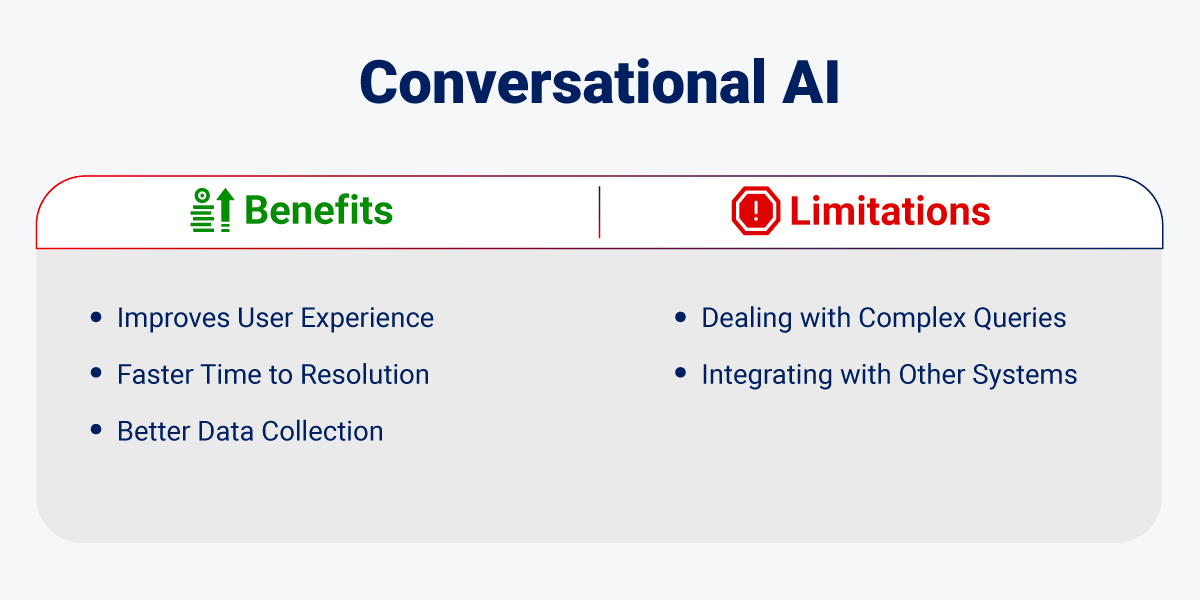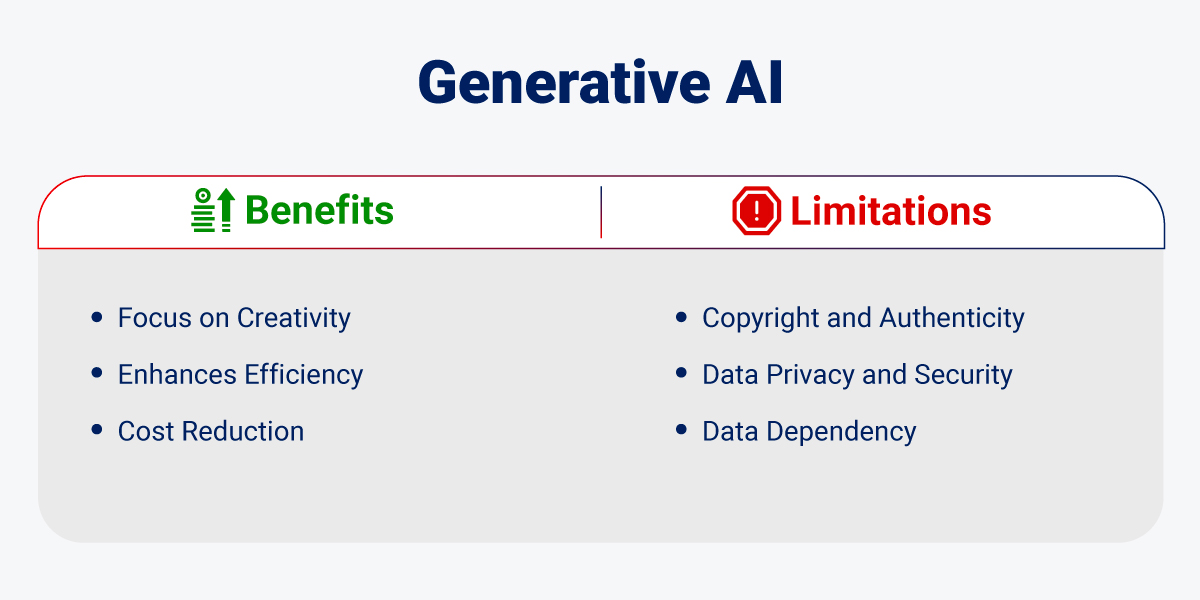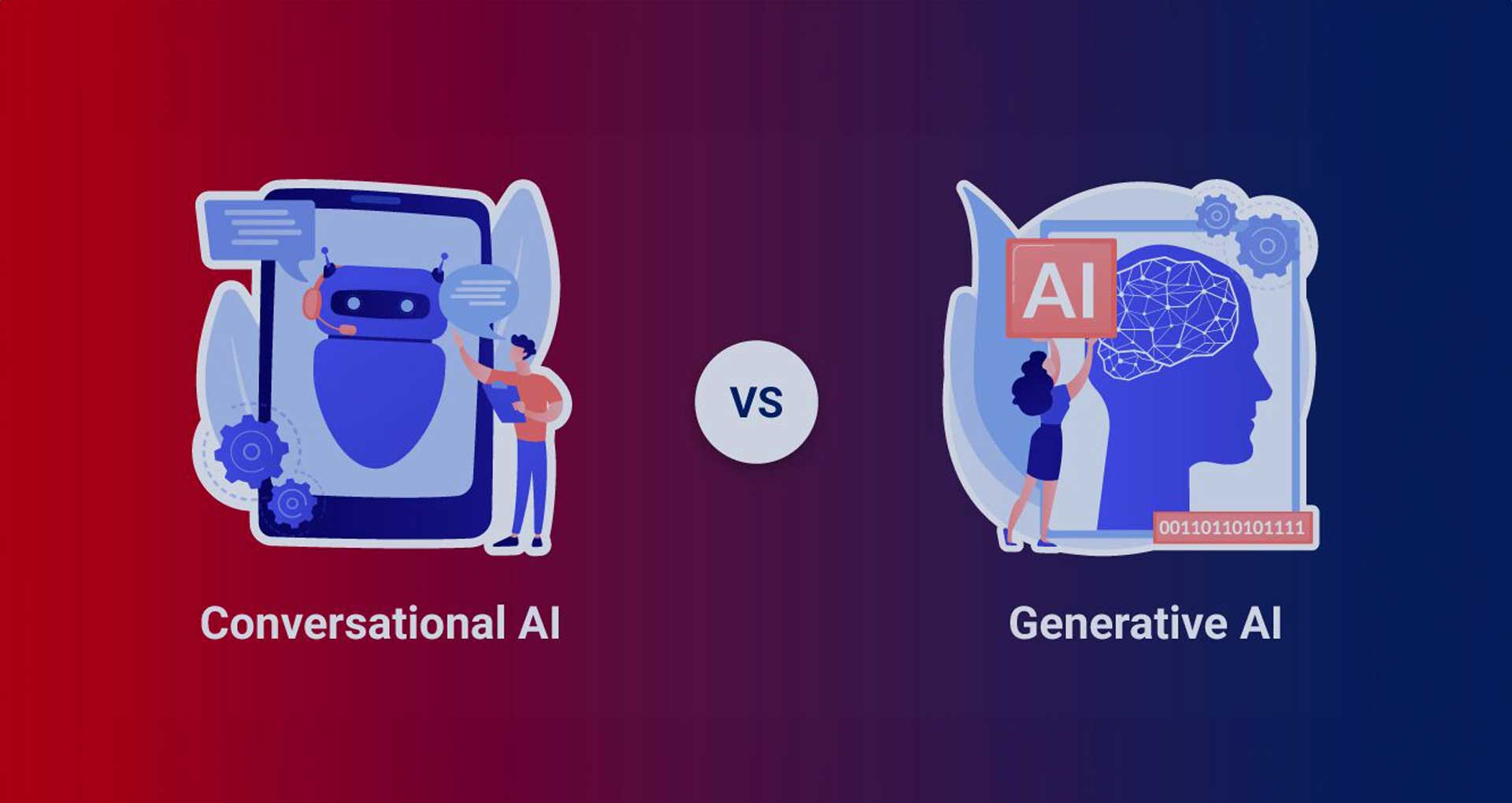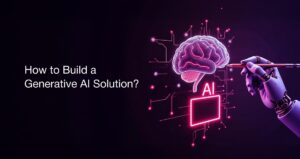In the AI era, enterprises are leveraging Conversational AI and Generative AI solutions as a high-tech Swiss Army Knife to create personalized experiences, create new revenue streams, and unleash efficiency and growth at scale. But before diving into using AI for your business to extract enterprise value, it is important to understand the unique capabilities and benefits of Conversational AI and Generative AI. Although They both utilize NLP, they are fundamentally different in their applications and focus. Conversational AI helps computers interact with people like humans, while Generative AI creates new content such as blogs, stories, workflows, and images.
Recognizing their differences is crucial for choosing the right solutions. In this blog on Generative AI vs Conversational AI, we will help clear up any confusion regarding the two. We’ll cover all relevant points, including an in-depth comparison, their benefits, limitations, and key use cases.
Conversational AI and Generative AI: Quick Explanation
Natural language processing has been instrumental in developing both Gen AI and conversational Gen AI within the rapidly expanding branch of artificial intelligence. Here, we will explore both these terms quickly.
Conversational AI
Conversational AI bridges the gap between humans and machines by enabling human-like conversations and understanding natural language. It can imitate human interaction, easily understand speech and text inputs, process information, and respond to users based on data drawn from a knowledge base or Conversational flow. This technology self-improves after each interaction, offering an improved experience over time.
According to reports, conversation AI market size is projected to reach $44.38 Bn by 2031, growing at a CAGR of 22.6%[1]
Generative AI
Generative AI is a deep learning model capable of generating fresh/new content, including audio, images, videos, text, and many more. It operates by responding to specific commands, understandable prompts, and instructions. It is rapidly driving advancements in automation and creativity by combining existing information to create new, contextually relevant, and accurate information.
Recent reports reveal that the market size for Generative AI is expected to reach $1.3 trillion by 2032, growing at a CAGR of 42%[2].
Conversational AI vs Generative AI: A Quick Comparison
While comparing both, it is crucial to understand their purpose, goals, applications, and more. Below is a quick comparison of Generative AI vs. Conversational AI in tabular format.
| Feature | Conversational AI | Generative AI |
| Purpose | Simulate human conversation | Create new content |
| Primary Techniques | Natural Language Processing (NLP), Machine Learning | Deep Learning, Generative Models( e.g., GANs, VAEs, Transformers) |
| Key Applications | Chatbots, virtual assistants, customer service | Art generation, text generation, music composition, code generation |
| Focus | Understanding and responding to human language | Creating original content based on learned patterns |
| Example Outputs | Text-based responses, voice interactions | Images, text, music, code |
| Data Requirements | Large datasets of human conversations and domain-specific knowledge | Large datasets of the specific content type to be generated (e.g., images, text, music, code and synthetic data) |
| Training Process | Employs supervised learning, where AI is trained on a labeled data set. | Utilizes unsupervised or semi-supervised learning, which enables AI to learn from large, unlabeled data to identify patterns and structures. |
| Evaluation Metrics | BLEU score, ROUGE score, human evaluation | Quality metrics specific to the generated content (e.g., image quality, text coherence, musicality) |
| Ethical Considerations | Bias in language models, privacy concerns, and potential for misuse, | Potential for misinformation, Ethical implications of generated content, such as deepfakes and copyright infringement. |
| Real-World Industry Applications | Customer service, education, healthcare, entertainment, finance, and many other industries | Art, design, marketing, research department |
Key Differences Between Conversational AI and Generative AI
Although choosing between these two depends on your business needs, certain key factors also influence this decision. Here, we discuss in-depth about GenAI vs Conversational AI to help you understand better.
1. Purpose and Functionality
Conversational AI: Its primary purpose is to facilitate communication with humans by utilizing natural language. The capability to understand natural language enables Conversational AI to easily process what humans are saying through text or voice, understand the intent and context, and respond appropriately. Conversational AI can also perform intent recognition, entity extraction, maintain conversation state for better communication.
Generative AI: Known primarily for its ability to create new content, its capabilities extend to data augmentation, expanding existing datasets to improve the performance of machine learning models. It also can create synthetic data, which can be invaluable for tasks like image classification, natural language processing, and testing in autonomous driving scenarios.
2. Data Input and Output
Conversational AI: These models primarily use text and audio data as inputs, generating responses in similar formats, with NLP techniques like tokenization and stemming playing a key role. Dialogue management, including state tracking and turn management, ensures that the conversation context is maintained while machine learning models like RNNs and transformers generate responses. Data preprocessing involves cleaning, normalizing, and feature engineering to improve model performance, with training through supervised and reinforcement learning. Evaluation is done using metrics like BLEU and ROUGE scores, along with user satisfaction surveys to assess interaction quality.
Generative AI: These models rely on a diverse dataset that includes text, images, audio, video, and numerical inputs to learn and generate fresh content. The architecture, often comprising neural networks like CNNs, RNNs, and GANs, influences the quality of output. During training, optimization algorithms and hyperparameter tuning help refine the model’s capabilities. After generation, sampling techniques and post-processing methods are used to enhance the final output, with both quantitative and qualitative metrics evaluating its effectiveness.
3. Training Data and Model Scope
Conversational AI: similar to Generative AI, this model also relies on large, high-quality, and diverse datasets to effectively learn and respond to user interactions. The complexity and scope of the model architecture, such as using transformers, determine its ability to handle various tasks, while regularization and transfer learning techniques help improve performance and generalization. Ensuring that the data captures context and diverse Conversational scenarios is key to developing robust, adaptable models.
Generative AI: It is a model that requires large, high-quality, and diverse datasets to learn and generate accurate content. The architecture plays a key role in balancing complexity and performance simultaneously. The model’s scope, capacity, and generalization must be carefully managed to avoid overfitting or underfitting, while techniques like transfer learning and regularization help enhance performance.
4. Creativity vs. Task Orientation
Conversational AI: As a task-oriented model, it is proficient in completing specific tasks and providing accurate information to customers/users efficiently. This makes it even a valuable tool across various domains such as healthcare, finance, and others. Its problem-solving capabilities enhance customer service, user experience, and information access across healthcare and finance by responding swiftly to complex queries. As the technology evolves, task-oriented AI is expected to handle increasingly complex tasks with greater personalization and human-like interactions.
Generative AI: It is revolutionizing computational creativity by producing novel and original content that challenges traditional boundaries across domains. Its ability to explore new ideas and collaborate with humans is driving innovation across fields like art, design, and content creation. As a rapidly evolving area, Generative AI promises to unlock new opportunities for human-machine collaboration, content generation, and idea generation across industries.
Generative AI vs Conversational AI: Key Advantages and Limitations
In the course of going through Conversational AI vs. Generative AI, we have learned that each has its respective purpose and goals, and both have their own pros and cons. Let’s now explore the advantages and limitations of Gen AI and Conversational AI together.

Advantages of Conversational AI:
- Improve Customer/Users Experience: Conversational AI enhances customer experience by offering personalized and efficient human-like interactions through NLP and machine learning techniques. By leveraging context understanding, sentiment analysis, and integrating customer data for tailored recommendations, businesses can create seamless, engaging experiences. Incorporating elements like gamification and voice assistants further boost customer satisfaction and loyalty.
- Faster Time to Resolution: Conversational AI can accelerate issue resolution by leveraging knowledge graphs for precise answers and advanced NLP for contextual understanding. It helps businesses optimize efficiency through intelligent routing, task automation, and proactive support. Seamless integration with other third-party systems allows us to continuously refine customer experience and drive operational excellence.
- Better Data Collection: Conversational AI capability to enhance data collection has been powered by NLP, enabling solutions like chatbots to perform contextual understanding and intent recognition for deeper insights. Businesses can also integrate it with CRM systems to serve data-driven approaches.
Limitations of Conversational AI:
- Handling Complex Queries: Conversational AI struggles with complex queries due to limitations in understanding deep context without knowledge graphs. It may be inadequate in handling multi-step or domain-specific questions and face challenges in maintaining long-term dialogue history.
- Integrating with Other Systems: Integrating Conversational AI with other platforms or systems can be challenging for any business. These challenges include ensuring seamless data exchange between diverse platforms, managing security and authentication complexities, and maintaining real-time data synchronization.

Advantages of Generative AI:
- Focus on Creativity: Generative AI produces fresh content at enormous volumes, enabling industries like marketing, advertising, and entertainment to generate ideas and develop engaging content in various formats (video, audio, text). Thus, Generative AI for businesses unlocks the path of creativity and innovation while also reducing time-consuming routine manual work.
- Enhances Efficiency: Besides creativity, one of the other advantages of Generative AI is its ability to offer businesses substantial efficiency gains in multiple ways, such as automating content creation, streamlining repetitive tasks such as content editing, image editing, and refining, prototyping creation, and many more compared to our imagination. This allows employees to focus on core activities, enhancing productivity through rapid content generation while reducing errors. Generative AI also supports advanced applications like predictive analytics, personalized marketing, and supply chain optimization, driving significant improvements in decision-making and customer engagement.
- Cost Reduction: Generative AI efficiently reduces costs for businesses by automating repetitive tasks such as content creation and marketing and lowering the need for human resources. It also enhances design and prototyping with innovative solutions and rapid development while optimizing supply chain processes through accurate demand forecasting and route planning. In drug discovery and financial modeling, for instance, GenAI accelerates research and improves risk assessment. By leveraging deep neural networks, transfer learning, and powerful computational resources, businesses can achieve greater cost savings.
Limitations of Generative AI:
- Copyright and Authenticity: Generative AI raises concerns about copyright and authenticity, as AI-generated content can closely resemble existing works, complicating originality assessments and intellectual property rights. Additionally, deepfakes created by AI threaten authenticity by potentially spreading misinformation and damaging reputations.
- Data Privacy and Security: Generative AI’s need for extensive training data raises privacy and security concerns. Biases in training data can often lead to the generation of content that perpetuates harmful stereotypes and discrimination in the generated content.
- Data Dependency: The efficiency and accuracy of Generative AI in producing content heavily depend on the quality and quantity of training data. Large, diverse, and high-quality datasets are crucial for generating relevant and accurate outputs. Thus, poor data collection and biased data sets can create blunders.
Conversational vs Generative AI: A Comparison of Use Cases
As AI rapidly evolves, there are many practical applications of both Conversational AI and Generative AI for businesses across industries. Here are some common yet critical use cases:
Conversational AI Applications
- Chatbot: Online chatbots are implemented on company websites, applications, and social media platforms to address customers’ questions and concerns and provide support for frequently asked issues.
- Virtual Assistant: Products such as Siri, Alexa, and Google Assistant offer voice control for many operations while interacting with apps and services.
- Omnichannel Support: Conversational AI can seamlessly integrate with mail, SMS, social media, and phone to offer consistent response and experience across various channels.
- AI-Powered Help Desks: In IT companies, handling and resolving multiple issues can become easier by integrating Conversational AI capabilities, such as support ticket management, troubleshooting, and more.
Generative AI Applications
- Creative Content and Art Generation: Generative AI enables industries to automate creative processes and drive innovation. For instance, it can prototype and instantly generate realistic images from text descriptions, making it a valuable asset for industries like advertising and entertainment, where rapid content creation is essential. In the fashion industry, AI generates designs or patterns, while in media, it composes music in various styles for films, games, and commercials.
- Education and Training: Beyond traditional education, businesses use AI to train employees through adaptive learning platforms that adjust to each learner’s pace. In industries like healthcare, AI simulates medical scenarios for training purposes, while gen AI in manufacturing assists in skill-based training through virtual simulations.
- Language Translation: Generative AI can be utilized for professional language translations, which provides more accurate and fluent translations in multiple languages through data-driven learning. This application of Gen AI helps businesses expand their operations/services globally by facilitating seamless communication with clients, partners, customers, and other associated entities across different languages.
Conversational AI vs Generative AI: When to Choose the Right One?
In the long-standing debate of Conversational AI vs. Generative AI, the dilemma of choosing between them always arises. So, if you are a business that is customer-facing and includes the process of continuous communication with various entities along with providing real-time support, then Conversational AI is the right choice. It’s the perfect solution for managing customer inquiries and engagement through virtual assistants and chatbots.
On the other hand, if you are looking for a solution or platform that efficiently generates fresh and unique content and creative materials or automates content creation, Generative AI is the better option. It excels in producing new text, images, music, or designs.
Partner with Rishabh Software to Integrate the Right AI Solution in Your Business Process
As a prominent AI development company, we can help you build and integrate custom Conversational and Generative AI solutions to drive your business growth. Our team of highly skilled and experienced AI engineers can help you build custom enterprise AI solutions for a connected software ecosystem to meet your specific business needs. Our team of AI, data analytics, and business intelligence experts have successfully executed various projects that fall under diverse industries, from healthcare and finance to retail and manufacturing. We understand the industry challenges and opportunities, which allows us to develop an AI-powered solution that directly addresses your unique business needs.
Whether you need Conversational AI solutions to achieve the aim of enhanced customer interactions or Generative AI solutions to automate and streamline workflows, our AI experts can develop custom, domain-specific Generative AI models and solutions. Partnering with Rishabh Software ensures that your AI journey is both seamless and impactful, unlocking the full potential of AI for your organization.
Frequently Asked Questions
Q: How are Conversational AI and Generative AI trained?
A: CAI is trained using dialogue datasets and natural language processing techniques. Whereas Generative AI is trained on large datasets to learn patterns.
Q: What are some real-world examples of Generative AI and Conversational AI?
- Generative AI: ChatGPT, Jukedeck, DeepArt, Google Gemini, Midjourney
- Conversational AI: Alexa, Google Assistant, Siri
Q: Can Conversational AI and Generative AI be used together?
A: Yes, they can be combined under a hybrid approach. For example, a chatbot powered by GPT-4 can use Generative AI to produce personalized, engaging responses in real-time based on user queries.
Footnotes:
1. https://www.coherentmarketinsights.com/industry-reports/Conversational-ai-market
2. https://www.bloomberg.com/company/press/Generative-ai-to-become-a-1-3-trillion-market-by-2032-research-finds/











 30 Min
30 Min


